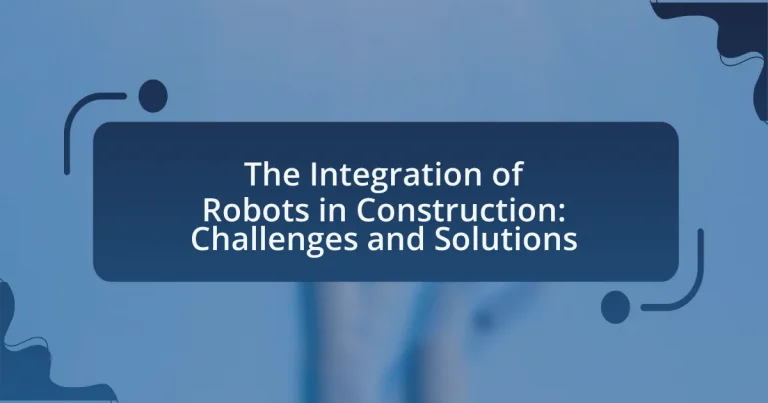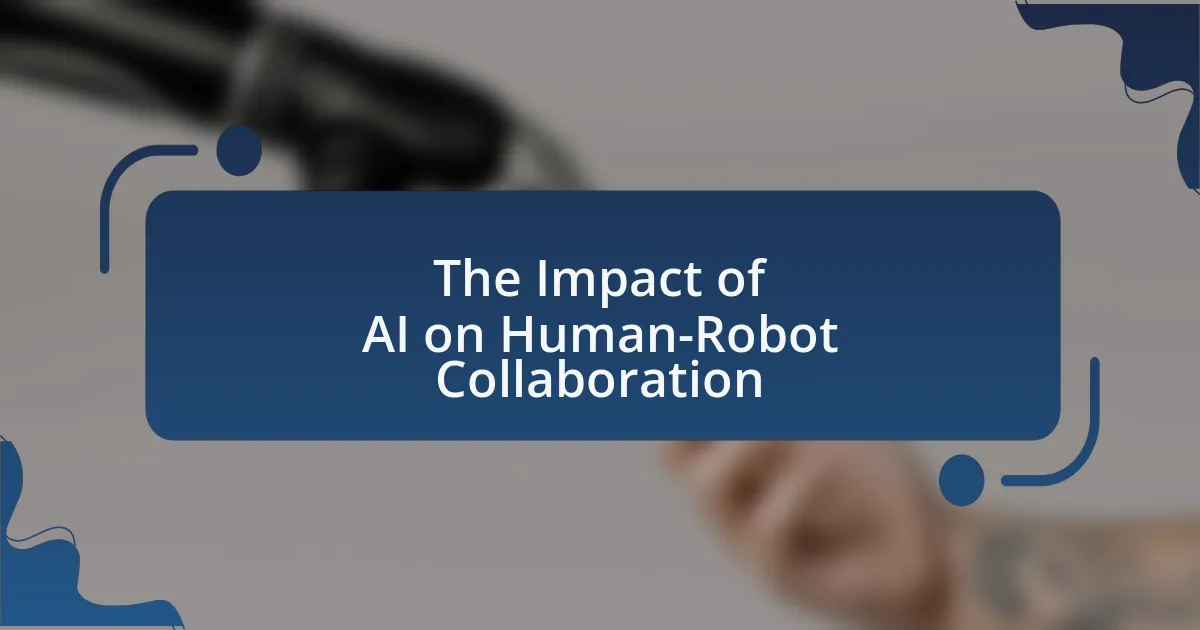The article focuses on the integration of robots in the construction industry, highlighting key aspects such as automation, safety, precision, and cost efficiency. It discusses how robots enhance efficiency by automating repetitive tasks, reducing labor costs, and improving project timelines. Specific tasks that robots can perform include bricklaying, concrete pouring, and site surveying, which contribute to increased productivity and safety. The article also addresses challenges related to high initial costs, technical limitations, and workforce implications, while proposing solutions like enhanced training and adaptable technologies to facilitate successful integration.
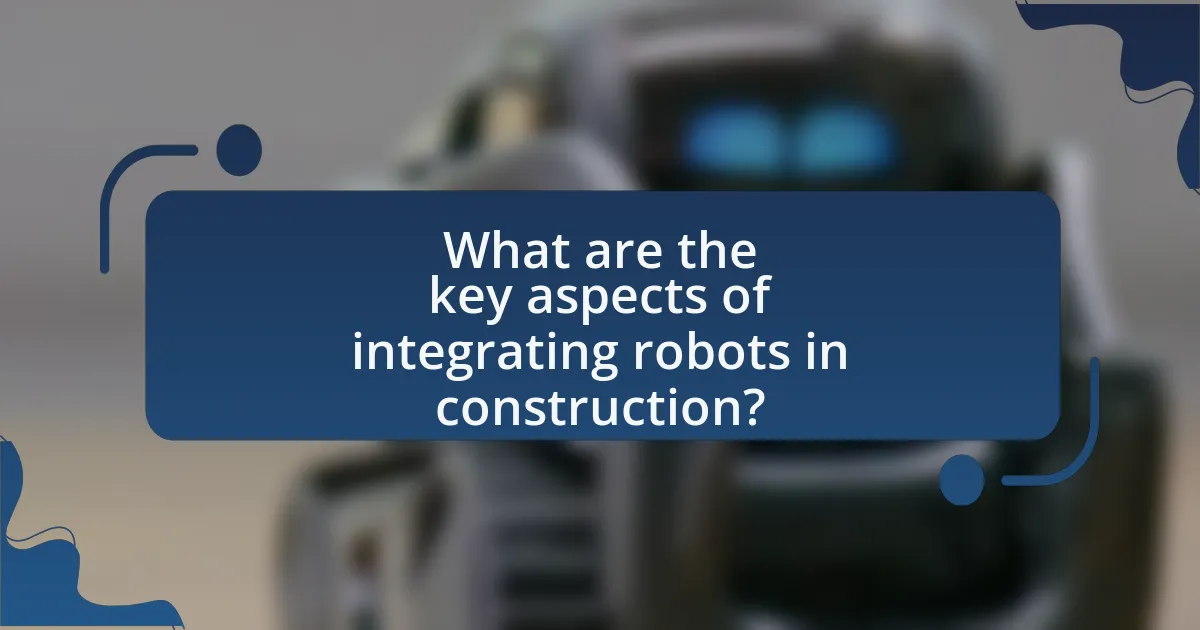
What are the key aspects of integrating robots in construction?
The key aspects of integrating robots in construction include automation of tasks, improved safety, enhanced precision, and cost efficiency. Automation allows robots to perform repetitive and labor-intensive tasks, reducing the need for manual labor and minimizing human error. Improved safety is achieved as robots can handle hazardous materials and operate in dangerous environments, thereby protecting workers. Enhanced precision is a significant benefit, as robots can execute tasks with high accuracy, leading to better quality construction outcomes. Cost efficiency is realized through reduced labor costs and increased productivity, as robots can work continuously without breaks. According to a study by McKinsey & Company, automation in construction could increase productivity by up to 50%, demonstrating the potential impact of integrating robots in the industry.
How do robots enhance efficiency in construction projects?
Robots enhance efficiency in construction projects by automating repetitive tasks, which reduces labor costs and increases productivity. For instance, robotic arms can perform tasks such as bricklaying and welding with precision and speed, completing jobs faster than human workers. According to a study by the McKinsey Global Institute, automation in construction could increase productivity by up to 50% by minimizing human error and optimizing workflows. Additionally, robots can operate in hazardous environments, reducing the risk of accidents and allowing human workers to focus on more complex tasks. This integration of robotics leads to streamlined operations and improved project timelines.
What specific tasks can robots perform on construction sites?
Robots can perform various specific tasks on construction sites, including bricklaying, concrete pouring, demolition, and site surveying. For instance, robotic bricklayers can lay bricks with precision and speed, significantly reducing labor time and increasing efficiency. Additionally, robots designed for concrete pouring can automate the mixing and application process, ensuring consistent quality and reducing waste. Demolition robots can safely dismantle structures, minimizing risks to human workers, while surveying drones can quickly gather site data and create accurate topographical maps. These applications demonstrate the growing role of robotics in enhancing productivity and safety in the construction industry.
How do robots impact project timelines and costs?
Robots significantly reduce project timelines and costs in construction by enhancing efficiency and precision. The integration of robots can lead to faster completion of tasks, such as bricklaying or welding, which traditionally require substantial manual labor. For instance, a study by the McKinsey Global Institute found that automation could increase productivity in construction by up to 20-30%. Additionally, robots minimize human error, which can lead to costly rework and delays. By streamlining processes and reducing labor costs, the overall financial burden of projects is lowered, making robotic integration a valuable investment in the construction industry.
What are the potential benefits of using robots in construction?
The potential benefits of using robots in construction include increased efficiency, enhanced safety, and improved precision. Robots can perform repetitive tasks faster than human workers, leading to reduced project timelines and lower labor costs. For instance, a study by the McKinsey Global Institute found that automation could increase productivity in construction by up to 20%. Additionally, robots can operate in hazardous environments, minimizing the risk of injury to human workers. This capability is supported by the use of robotic systems for tasks such as bricklaying and demolition, which can significantly lower accident rates on job sites. Furthermore, robots provide consistent quality in construction tasks, as they are programmed to execute tasks with high accuracy, reducing errors and material waste.
How do robots improve safety for construction workers?
Robots improve safety for construction workers by performing hazardous tasks that reduce the risk of injury. For instance, robots can handle heavy lifting, operate in dangerous environments, and conduct inspections in areas that may pose safety threats to human workers. According to a study by the National Institute for Occupational Safety and Health, the use of robotic systems in construction can lead to a significant decrease in workplace accidents, with reports indicating a reduction of up to 30% in injury rates when robots are utilized for high-risk tasks. This evidence underscores the effectiveness of robots in enhancing safety protocols on construction sites.
What advantages do robots offer in terms of precision and quality?
Robots offer significant advantages in precision and quality by executing tasks with a high degree of accuracy and consistency. Their ability to perform repetitive actions without fatigue ensures that each operation meets strict specifications, reducing the likelihood of human error. For instance, studies have shown that robotic systems can achieve precision levels within micrometers, which is crucial in construction applications such as prefabrication and assembly. Additionally, robots can maintain quality control by utilizing advanced sensors and algorithms to detect defects in real-time, thereby ensuring that the final product adheres to the desired standards. This combination of accuracy and reliability enhances overall project outcomes in the construction industry.
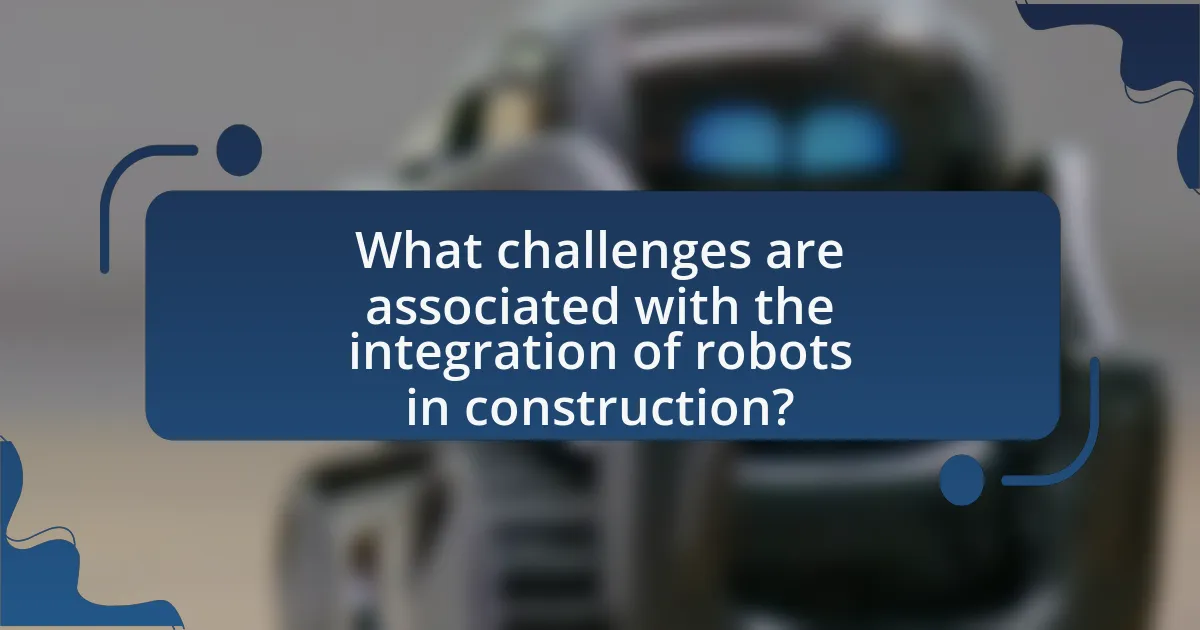
What challenges are associated with the integration of robots in construction?
The integration of robots in construction faces several challenges, including high initial costs, technical limitations, and workforce resistance. High initial costs arise from the investment required for advanced robotic systems and their implementation, which can deter companies from adopting this technology. Technical limitations include issues related to the adaptability of robots to various construction environments and tasks, as many robots are designed for specific functions and may struggle with the variability of construction sites. Workforce resistance is another significant challenge, as construction workers may fear job displacement or lack the necessary skills to work alongside robotic systems, leading to reluctance in embracing this technological shift. These challenges highlight the complexities involved in successfully integrating robots into the construction industry.
What are the technical limitations of current construction robots?
Current construction robots face several technical limitations, including limited mobility, lack of adaptability to complex environments, and insufficient precision in tasks. Limited mobility restricts robots to specific terrains and conditions, making them less effective in diverse construction sites. The inability to adapt to varying tasks and unexpected changes in the environment hampers their functionality, as many robots are designed for specific applications and struggle with versatility. Additionally, precision issues arise from the challenges of working with intricate designs and materials, which can lead to errors in construction processes. These limitations highlight the need for advancements in robotics technology to enhance performance in the construction industry.
How do environmental factors affect robot performance on construction sites?
Environmental factors significantly impact robot performance on construction sites by influencing their operational efficiency and reliability. For instance, extreme weather conditions such as rain, snow, or high temperatures can hinder a robot’s mobility and sensor accuracy, leading to decreased productivity. Research indicates that robots operating in adverse weather conditions may experience a 30% reduction in task completion rates due to impaired navigation and increased energy consumption. Additionally, varying terrain types, such as uneven surfaces or obstacles, can affect a robot’s ability to perform tasks effectively, as demonstrated by studies showing that robots struggle with stability and traction on rugged ground. These environmental challenges necessitate the development of adaptive technologies and robust designs to enhance robot performance in diverse construction settings.
What are the challenges related to robot maintenance and repair?
The challenges related to robot maintenance and repair include the complexity of robotic systems, the need for specialized knowledge, and the high costs associated with repairs. Robotic systems often consist of intricate components and software that require skilled technicians for effective maintenance. According to a study by the International Federation of Robotics, the demand for skilled labor in robotics maintenance is increasing, highlighting the shortage of qualified personnel. Additionally, the costs of replacement parts and the potential downtime during repairs can significantly impact project timelines and budgets in construction settings.
What are the workforce implications of integrating robots in construction?
Integrating robots in construction significantly impacts the workforce by reducing the demand for manual labor while simultaneously creating new roles focused on robot management and maintenance. As robots take over repetitive and hazardous tasks, the need for skilled labor decreases, leading to potential job displacement for workers in traditional roles. However, this shift also necessitates the development of new skills, as workers will need training in robotics, programming, and system management to operate and maintain these machines effectively. According to a report by the McKinsey Global Institute, automation could displace up to 30% of the global workforce by 2030, but it also emphasizes the creation of new job categories that require advanced technical skills. Thus, while the integration of robots poses challenges in terms of job loss, it also opens opportunities for workforce evolution and upskilling.
How does robot integration affect job roles and employment in the industry?
Robot integration significantly alters job roles and employment in the industry by automating repetitive tasks, which can lead to job displacement for low-skilled workers while simultaneously creating new opportunities for skilled positions in robotics management and maintenance. For instance, a study by the McKinsey Global Institute found that up to 30% of tasks in various industries could be automated by 2030, necessitating a workforce that is more technologically adept. This shift requires workers to adapt by acquiring new skills, particularly in programming and robotics, thereby transforming the labor market dynamics.
What skills are necessary for workers to effectively collaborate with robots?
Workers need technical skills, problem-solving abilities, and effective communication skills to collaborate effectively with robots. Technical skills enable workers to understand and operate robotic systems, while problem-solving abilities help them address challenges that arise during collaboration. Effective communication skills are essential for coordinating tasks and ensuring that both human workers and robots can work together seamlessly. Research indicates that as automation increases in construction, these skills become critical for maintaining productivity and safety on job sites.
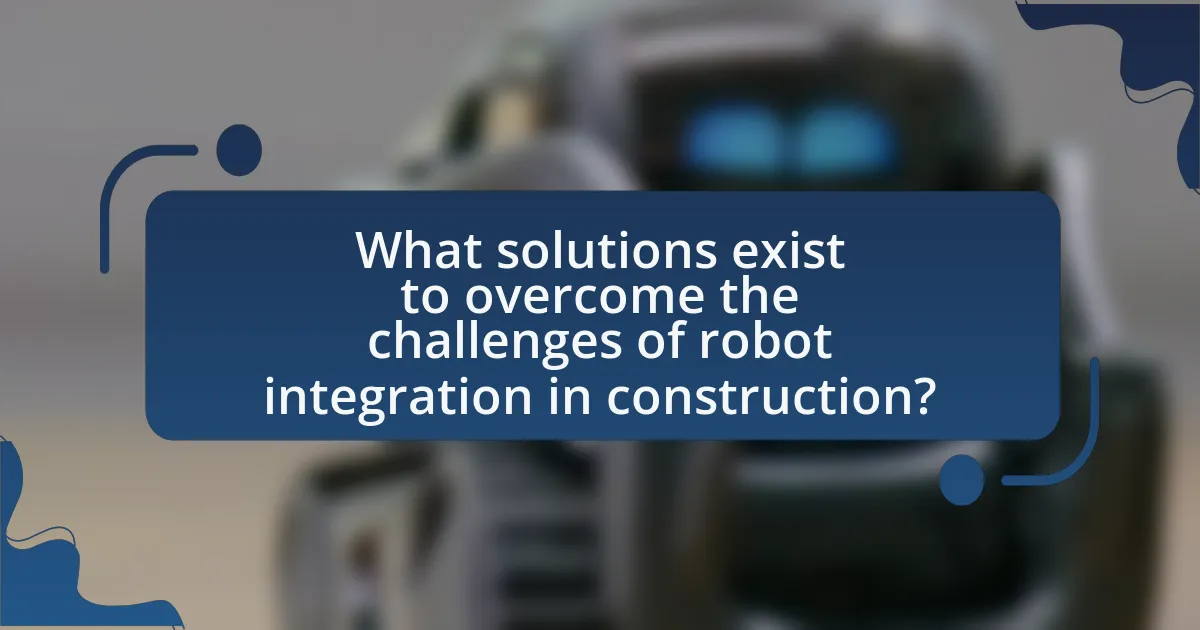
What solutions exist to overcome the challenges of robot integration in construction?
Solutions to overcome the challenges of robot integration in construction include developing standardized protocols, enhancing workforce training, and investing in adaptable robotic technologies. Standardized protocols facilitate seamless communication between robots and existing construction systems, reducing integration complexity. Enhanced workforce training ensures that human workers can effectively collaborate with robots, addressing concerns about job displacement and operational efficiency. Investing in adaptable robotic technologies allows for flexibility in various construction tasks, accommodating different project requirements and environments. These strategies collectively address the primary barriers to successful robot integration in the construction industry.
How can training programs be developed for workers to adapt to robotic technologies?
Training programs for workers to adapt to robotic technologies can be developed by implementing a structured curriculum that focuses on both technical skills and soft skills. This curriculum should include hands-on training with robotic systems, simulations, and real-world applications to ensure workers gain practical experience.
For instance, a study by the International Federation of Robotics highlights that effective training programs incorporate interactive learning methods, such as virtual reality simulations, which enhance understanding and retention of robotic operations. Additionally, collaboration with industry experts to create tailored training modules can address specific challenges faced in construction environments, ensuring relevance and applicability.
Furthermore, ongoing assessment and feedback mechanisms should be integrated into the training process to adapt the programs based on worker performance and technological advancements, thereby maintaining the effectiveness of the training over time.
What best practices can be implemented for effective human-robot collaboration?
Effective human-robot collaboration can be achieved by implementing clear communication protocols, ensuring safety measures, and fostering mutual understanding of roles. Clear communication protocols, such as standardized signals or interfaces, help both humans and robots understand tasks and expectations, reducing errors. Safety measures, including physical barriers and emergency stop functions, protect human workers from potential hazards posed by robots. Additionally, fostering mutual understanding of roles through training and collaborative exercises enhances teamwork, allowing humans and robots to complement each other’s strengths. Research indicates that organizations that prioritize these best practices experience improved efficiency and reduced accidents in collaborative environments.
How can companies ensure ongoing support and maintenance for construction robots?
Companies can ensure ongoing support and maintenance for construction robots by implementing a structured maintenance program that includes regular inspections, software updates, and training for operators. Regular inspections help identify wear and tear, while software updates ensure that robots operate with the latest features and security patches. Training for operators is crucial, as it enhances their ability to troubleshoot minor issues and perform routine maintenance tasks effectively. According to a study by the International Journal of Advanced Robotic Systems, companies that adopt proactive maintenance strategies can reduce downtime by up to 30%, demonstrating the effectiveness of these practices in maintaining operational efficiency.
What role does technology play in enhancing robot capabilities in construction?
Technology significantly enhances robot capabilities in construction by enabling advanced automation, precision, and efficiency. Innovations such as artificial intelligence, machine learning, and sensor technologies allow robots to perform complex tasks, adapt to dynamic environments, and improve decision-making processes. For instance, the use of AI algorithms in robotic systems can optimize construction schedules and resource allocation, leading to reduced project timelines and costs. Additionally, advancements in robotics, such as collaborative robots (cobots), facilitate safer interactions between human workers and machines, enhancing overall productivity on construction sites. These technological integrations have been shown to increase construction efficiency by up to 30%, demonstrating their critical role in modern construction practices.
How can advancements in AI and machine learning improve robot performance?
Advancements in AI and machine learning can significantly improve robot performance by enhancing their ability to learn from data, adapt to new environments, and make real-time decisions. For instance, AI algorithms enable robots to analyze vast amounts of construction data, optimizing tasks such as material handling and site monitoring. Research by MIT demonstrated that machine learning models could predict equipment failures with over 90% accuracy, allowing for proactive maintenance and reducing downtime. This capability not only increases efficiency but also ensures safety on construction sites by enabling robots to navigate complex environments and avoid obstacles effectively.
What innovations are on the horizon for construction robotics?
Innovations on the horizon for construction robotics include advancements in autonomous machinery, collaborative robots (cobots), and artificial intelligence integration. Autonomous machinery is expected to enhance efficiency by performing tasks such as excavation and material handling without human intervention, as demonstrated by companies like Built Robotics, which has developed retrofitted construction equipment capable of operating autonomously. Collaborative robots are designed to work alongside human workers, improving safety and productivity; for instance, firms like Boston Dynamics are creating robots that can assist in lifting heavy materials. Additionally, the integration of artificial intelligence will enable robots to learn from their environments and adapt to changing conditions on construction sites, as evidenced by research from the Massachusetts Institute of Technology, which highlights AI’s potential to optimize construction workflows and reduce costs.
What are the best practices for successfully integrating robots in construction projects?
The best practices for successfully integrating robots in construction projects include thorough planning, effective training, and continuous evaluation. Thorough planning involves assessing project requirements and selecting appropriate robotic technologies that align with specific tasks, such as bricklaying or demolition. Effective training ensures that human workers understand how to collaborate with robots, enhancing safety and efficiency. Continuous evaluation of robot performance and integration processes allows for adjustments and improvements, ensuring that the technology meets evolving project needs. Research indicates that construction projects that implement these practices experience increased productivity and reduced labor costs, demonstrating the effectiveness of strategic integration.
